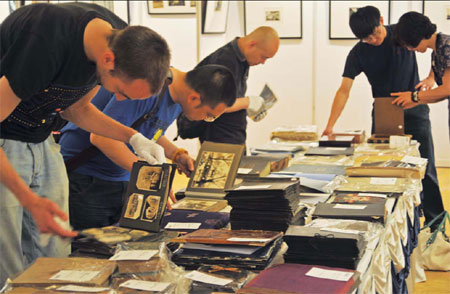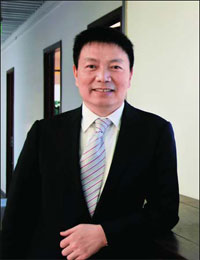Set up for major photo opportunity
Updated: 2013-03-08 08:55
By Sun Yuanqing (China Daily)
|
|||||||||||
|
In the West, contemporary photos have been at the forefront of interest, but in China, most collectors are keen on historical pictures. Provided to China Daily |
|
Gan Xuejun is the founder and general manager of Beijing Huachen Auctions. Provided to China Daily |
Photography pulls focus in art market as sales of other forms fall
Although considered a major art form in the West, photography has been very much edge-of-frame in China.
But with the sharp downturn in the country's art market, the work of the camera is coming into its own.
"Photographs were the only exception for us in the downturn last year," says Li Xin, the image department manager for Beijing Huachen Auctions, the only Chinese auction house that has photography as an independent category.
And where sourcing artwork to auction is a headache for many companies at the moment, there is no problem finding photographs, as prices keep rising for them, she says.
Huachen generated more than 13 million yuan ($2 million; 1.6 million euros) in photography sales last year, up from 12 million yuan in 2011.
"During the past 10 years, there has been a significant increase in price for photography," says Terry Bennett, a London collector of old Chinese photographs and author of the book series History of Photography in China.
"It is hard to generalize, but today we can expect to pay two or even three times the earlier prices. Rare early material can fetch even higher prices."
There are about 300 collectors of photographic works in China. Xue Manzi, a well-known angel investor, and Zhu Yong, a printing entrepreneur, from Beijing, have been major clients of Huachen, accounting for about half the sales. Both are reported to have invested tens of millions of yuan in photographs.
"Photography in China is still undervalued," says Zhu Yong. "It will take a while to realize its true value, and auction is a better way to do that than through dealers, because it's more transparent."
As a younger art form, photography has yet to see an incursion of speculators and fakes that have bedeviled other sectors of the Chinese art market.
Li says she has not seen anyone dodge payment after winning a bid, which is rare, given the overall rate for defaulting on payment in art auctions in China in 2011 was more than 55 percent.
Founded in 2006, Huachen's image department lost money on its first auction and struggled to make ends meet for the next few years.
"I was always very depressed after the auctions," Li says.
"No matter how hard we worked, we could never compete with the other departments."
With the only two other competitors - Guardian, China's second-largest auction house, and Beijing Cheng Xuan Auctions - dropping their photography sections after the 2008 global financial crisis, Huachen became the only player in the market.
"We thought about giving up, and even canceled one auction in 2009, but we met unexpected opposition from clients," Li recalls. "They were saying, 'How can you do that? You have responsibilities. You can't just quit. What are you going to say to us, to the market and to the public?'"
However, in 2011 Huachen's photographic division snapped success during the boom in China's art market. The autumn auction that year raised more than 7.6 million yuan, compared with the 2-3 million yuan levels of previous auctions. A collection of photos of Zhou Xuan, a popular singer and actress in the 1940s, broke the record for a photo auction in China, fetching 2.2 million yuan.
Li attributes the growth to the early years of nurturing the market, including work on the classification system, evaluation standard, and pricing mechanism.
Other institutions have also contributed to the cultural growth of photography in China. There are about 25 museums that include photographs in their collections, and photographic galleries have sprung up around the country, including the MR Gallery in Beijing, established after its founder attended a Huachen auction.
"Some collectors say they are doing it for the country as the authorities have yet to recognize the value of old photographs," Li says. "They do it in the hope of building a museum and leaving some memories for the nation."
However, Li bemoans the fact that the Huachen auction house is the only picture show in town.
"We are still the only player in the market. And it cannot improve without participation and competition from others."
Another drawback is the lack of information sources and reference standards.
"After seven years, the market is still in its very early stage, because we don't have a complete history of Chinese photography to refer to," Li says. "And we don't have a photography museum to inform our work."
Collector and author Bennett believes "the market is still unstable", partly due to price speculation.
"The present vacuum in knowledge and uncertainty are contributing to market instability. There are still only a handful of useful books on early China photography. The absence of a dedicated photography museum in China is a drawback, and especially the absence of the necessary tools to identify the photographers of so many of the early photographs."
While early Western photographers of China, such as John Thomson, William Saunders and Thomas Child, are becoming better known, the work of the early Chinese master photographers, such as Lai Fong, Tung Hing and Pow Kee, is still largely unknown, Bennett says.
"As their work becomes increasingly identified, critiqued and compared to their Western contemporaries, the market will adjust and become rather more stable," he says.
Huachen now concentrates on documentary and old photographs, but is looking at more recent work.
While contemporary photos have been leading the way in the West, Chinese collectors mostly have an eye for historical pictures.
"People find it hard to empathize with modern art," says Guan Yu, director and general manager of the research firm Art Market Monitor of Artron in BeijingGuan. "They are still learning. When it comes to investment, they tend to choose traditional art."
Li, however, makes sure that 10 percent of every auction is dedicated to contemporary photographers. Contemporary works sold out last year.
"Sources of old photographs are limited. Contemporary is where our future is and we have to gear up. There are truly good works among the contemporary artists, and we want to help and encourage them."
Photography accounts for less than 5 percent of Huachen's total revenue, but company founder and general manager Gan Xuejun sees that increasing.
"It's not only about photographs, it's about making up for the lapses in the past," he says. "It's easy to sell whatever is profitable at the moment, but what about in five years? How do we prepare for that? Photography is not a money machine at present, but it's an opportunity to build ourselves as a professional brand."
sunyuanqing@chinadaily.com.cn
(China Daily 03/08/2013 page15)
Today's Top News
List of approved GM food clarified
ID checks for express deliveries in Guangdong
Govt to expand elderly care
University asks freshmen to sign suicide disclaimer
Tibet gears up for new climbing season
Media asked to promote Sino-Indian ties
Shots fired at Washington Navy Yard
Minimum growth rate set at 7%
Hot Topics
Lunar probe , China growth forecasts, Emission rules get tougher, China seen through 'colored lens', International board,
Editor's Picks

|

|

|

|

|

|







